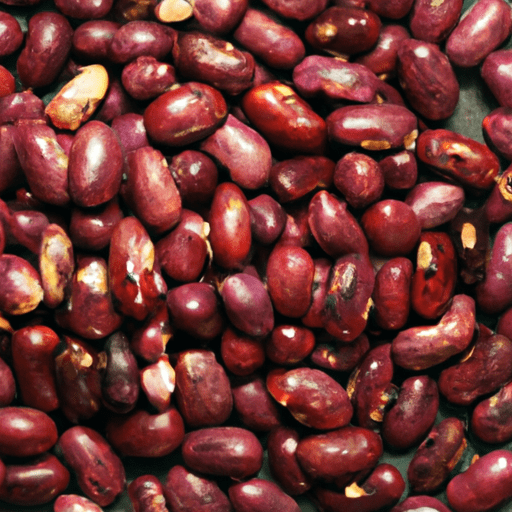Discover the Delightful World of Dried Cranberry Beans
Are you ready to step into the vibrant world of legumes? Look no further than the charming dried cranberry bean. Known for its intriguing colors, delightful flavor, and versatile nature, this beloved bean has been a staple in kitchens for centuries. In this blog post, we will unveil everything you need to know about dried cranberry beans, from their taste and uses in cooking to their nutritional value and intriguing history. So, let’s dive right in!
A Flavorful Feast for the Senses
Dried cranberry beans, also known as borlotti beans or romano beans, are a visually stunning addition to any dish. These medium-sized beans boast a distinctive marbled pattern of cream, pink, and red hues. Their enchanting appearance is surpassed only by their delightful flavor.
When cooked, dried cranberry beans offer a creamy texture with a slightly nutty taste. Their flavor profile is often described as earthy, mild, and reminiscent of chestnuts. These beans have a unique ability to absorb the flavors of the ingredients they are cooked with, making them a versatile choice for both hearty dishes and delicate creations.
Unleashing Culinary Creativity
Dried cranberry beans possess the remarkable ability to elevate a wide range of dishes. Here are a few of our favorite ways to make the most of these versatile legumes:
Soups and Stews: Dried cranberry beans shine in comforting soups and stews. Their creamy texture and ability to absorb flavors make them an excellent choice for hearty bean-based soups, such as Tuscan-style ribollita or classic chili.
Salads: Adding cooked and cooled cranberry beans to salads adds a delightful and satisfying element. Whether combined with fresh herbs, roasted vegetables, or tossed in a zesty vinaigrette, these versatile beans bring a unique textural and visual appeal to any salad creation.
Mash or Spread: Transform cooked cranberry beans into a sumptuous spread or mash. Simply puree the beans with garlic, lemon juice, and herbs for a delightful dip or a flavorful filling for wraps and sandwiches.
Pasta and Rice Dishes: Add an unexpected twist to your pasta or rice dishes by incorporating cooked cranberry beans. Their rich flavor pairs beautifully with fragrant herbs, roasted vegetables, and delicate sauces.
Nutritional Bonanza
Embracing dried cranberry beans isn’t just a culinary choice; it’s a sensible nutritional decision too. These legumes offer an array of health benefits, making them a valuable addition to any well-rounded diet:
Protein Powerhouse: Dried cranberry beans provide a hearty dose of plant-based protein, making them a fantastic option for vegetarians and vegans seeking alternative protein sources.
Fiber-Rich Goodness: Loaded with dietary fiber, cranberry beans support healthy digestion and help regulate blood sugar levels. They also contribute to a lasting feeling of fullness, making them a valuable addition to a weight-conscious diet.
Vitamins and Minerals: Dried cranberry beans contain essential vitamins and minerals, including folate, magnesium, iron, and potassium. These micronutrients are vital for maintaining overall health and supporting various bodily functions.
A Glimpse into Bean History
Beans have long been an integral part of culinary traditions worldwide, and dried cranberry beans are no exception. Native to the Americas, cranberry beans have a rich history dating back centuries. Their cultivation expanded throughout Europe during the Columbian Exchange, where they quickly became a beloved ingredient in Italian and Mediterranean cuisine.
The name “cranberry bean” derives from the beans’ resemblance to cranberries when cooked, displaying similar reddish hues. Embedded in their vibrant appearance lies a sense of culinary heritage, providing a wonderful connection to the past as we continue to enjoy these magnificent legumes today.
In Conclusion
Dried cranberry beans are a true culinary treasure, offering not only a visually stunning presence but also a delightful taste and remarkable versatility. Whether you incorporate them into soups, salads, spreads, or pasta dishes, their creamy texture and unique flavor will undoubtedly make your recipes shine. Moreover, their impressive nutritional profile makes them a sensible choice for a well-rounded diet.
So, why not embark on your culinary journey today and savor the remarkable qualities of dried cranberry beans? Explore the endless possibilities they offer and embrace their vibrant hues, delightful flavor, and rich history. Your taste buds and your health will thank you for it!
Have you had the pleasure of cooking with dried cranberry beans? Share your favorite recipe or cooking experience in the comments below!
Dried Cranberry Beans
Origin: Dried cranberry beans, also known as borlotti beans, originated in Italy. They are a popular staple in Italian cuisine and are cultivated in various regions such as Tuscany, Piedmont, and Veneto.
Appearance and Common Uses: Dried cranberry beans are large, oval-shaped beans with a speckled cranberry-red and cream-colored skin. When cooked, they have a creamy texture and a nutty, mild flavor. They are commonly used in soups, stews, salads, and pasta dishes, and are also mashed to make spreads or dips.
Nutritional Benefits: Dried cranberry beans are a nutritious ingredient that provides several health benefits. They are an excellent source of protein, dietary fiber, and folate. Additionally, they contain significant amounts of potassium, magnesium, iron, and B vitamins. Consuming cranberry beans can contribute to a balanced diet and support overall health.
Unique Properties: One notable characteristic of cranberry beans is their ability to absorb flavors during cooking, making them an excellent choice for dishes with aromatic spices and herbs. Their cream-colored flesh develops a speckled appearance as they cook, providing an appealing visual element to dishes.
Historical Significance: Cranberry beans have been cultivated for centuries and were introduced to different regions through trade and exploration. They have played a significant role in Italian cuisine, particularly in traditional dishes like pasta e fagioli and minestrone soup. Today, dried cranberry beans are enjoyed by many cultures worldwide, contributing to the richness of various culinary traditions.




Use the share button below if you liked it.
It makes me smile, when I see it.